Category: Recommended Reading
Ludwig Wittgenstein’s ‘Word Book’
Corina Copp at Bomb Magazine:
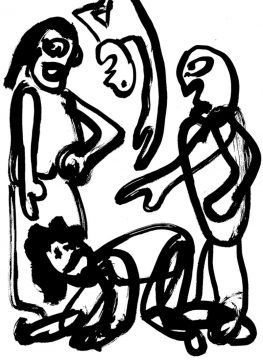 Silliness is not such a stretch as one would think, should one think of Wittgenstein. The ludic is at play, from conception, in the language-game itself; or the duck-rabbit as a vehicle of ambiguity, a perceptual “third thing,” a visual neologism: now ears … now beak, or “Both; not side-by-side, however, but about the one via the other.” Silliness is ruminative, i.e., we must look back over time for its sense to resonate. And it seeks a beyond. I consider the question of whether the two-headed calf should be counted as one animal or two—a serious moment for the Vatican Belvedere Gardens of 1625. Three, of course. “For the physicians, the feature distinguishing the individual was the brain; for followers of Aristotle, the heart,” wrote Carlo Ginzburg. And the dissection of the animal “was done with the aim of establishing not the ‘character’ peculiar to that particular animal, but ‘the common character’ … of the species as a whole.” A parallelism: Wittgenstein’s insistence that a student learn a new word by experiencing it through practice, being responsible to it and its usage, and eventually making the word meaningful for a greater understanding of her (whole) (linguistic) (yet shared, and seen) world.
Silliness is not such a stretch as one would think, should one think of Wittgenstein. The ludic is at play, from conception, in the language-game itself; or the duck-rabbit as a vehicle of ambiguity, a perceptual “third thing,” a visual neologism: now ears … now beak, or “Both; not side-by-side, however, but about the one via the other.” Silliness is ruminative, i.e., we must look back over time for its sense to resonate. And it seeks a beyond. I consider the question of whether the two-headed calf should be counted as one animal or two—a serious moment for the Vatican Belvedere Gardens of 1625. Three, of course. “For the physicians, the feature distinguishing the individual was the brain; for followers of Aristotle, the heart,” wrote Carlo Ginzburg. And the dissection of the animal “was done with the aim of establishing not the ‘character’ peculiar to that particular animal, but ‘the common character’ … of the species as a whole.” A parallelism: Wittgenstein’s insistence that a student learn a new word by experiencing it through practice, being responsible to it and its usage, and eventually making the word meaningful for a greater understanding of her (whole) (linguistic) (yet shared, and seen) world.
more here.
Friday Poem
After the Election: A Father Speaks to His Son
He says, they will not take us.
They want the ones who love
another god, the ones whose
joy comes with five prayers and
songs to the sun in the mornings
and at night. He says, they will
not want us. They want the ones
whose tongues stumble over
silent e’s, whose voices creak
when a th suddenly appears
in the middle of a word.
They want the ones who cannot hide
copper skin like we can. He says,
I am old. I lived through one revolution.
We can hide our skin.
We have read the books.
He says, we are the quiet kind, the ones
who stay late and do not speak,
the ones who do not bring trumpets
or trouble. He says, we are safe in silence.
We must become ghosts.
I think, so many are already dust.
tried to stay thin, be small, tried
breaking bone and voice, tried
to be soft. So many tried to be
empty, to be barely breath. To be
still enough to be left alone. Become
shadows, trying not to be bodies.
It never works. To become nothing.
They come for the shadows, too.
by M. Soledad Caballero
from Split This Rock
Spinoza on How to Live and How to Die
Jonathan Rée at Literary Review:
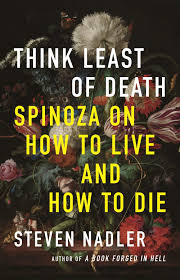 When he died in 1677 at the age of forty-four, Spinoza left behind a compact Latin manuscript, Ethics, and his disciples quickly got it printed. It is a book like no other. It urges us to change our whole way of thinking and in particular to rid ourselves of the deep-rooted conceit that makes us imagine that our petty, transient lives might have some ultimate significance. The argument is dynamic, disruptive and upsetting, but it is contained within a literary framework of extraordinary austerity, comprising an array of definitions, axioms, propositions, proofs and scholia. The overall effect is not so much beautiful as sublime, like watching a massive fortress being shaken by storms and earthquakes. Many readers have found themselves deeply moved by Ethics but unable to say exactly what it means.
When he died in 1677 at the age of forty-four, Spinoza left behind a compact Latin manuscript, Ethics, and his disciples quickly got it printed. It is a book like no other. It urges us to change our whole way of thinking and in particular to rid ourselves of the deep-rooted conceit that makes us imagine that our petty, transient lives might have some ultimate significance. The argument is dynamic, disruptive and upsetting, but it is contained within a literary framework of extraordinary austerity, comprising an array of definitions, axioms, propositions, proofs and scholia. The overall effect is not so much beautiful as sublime, like watching a massive fortress being shaken by storms and earthquakes. Many readers have found themselves deeply moved by Ethics but unable to say exactly what it means.
more here.
The battle for the soul of America In today’s culture wars, the future of the republic
Frank Ferudi in Sp!ked:
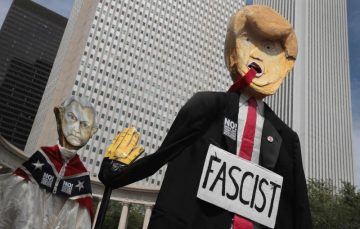
Historically, US presidential elections were dominated by competing views on economic and social issues. No longer. This approaching election has increasingly been consumed by a cultural conflict, at the heart of which is a war over American history. But this is no mere disagreement over the precise details of what happened three or four centuries ago. It is a battle for the very soul of the United States. The principal battle is being fought over the founding of the US. As we will see, this is best captured, by, on one side, the New York Times’ 1619 Project, which contends America was founded when African slaves first arrived in Jamestown; and, on the other, President Donald Trump’s mooted 1776 Commission, which reasserts the traditional, would-be inspiring narrative of revolution and independence as America’s founding moment.
All of this raises questions of the utmost importance. Why has America’s founding become such a vital issue in the 21st century? And, more broadly, how should humanity engage with the legacy of its past achievements?
History has rarely appeared more alive than it does in the West today. Even before the Black Lives Matters protests this summer, protesters had been treating symbols of the past, be they building names or statues, as if they were living things. Some protesters even claim that these inanimate objects pose a threat to their wellbeing, with some Rhodes Must Fall campaigners at the University of Oxford claiming that merely walking past Cecil Rhodes’ statue is traumatic. Many more treat these symbols of the past as if they are living adversaries, against whom every act of vandalism or toppling is a vital act. You could see something of this when activists pulled down the statue of Edward Colston in Bristol earlier this year. They did not simply want to topple it. They wanted to defile it, humiliate it, debase it. And so they pulled it down, and then dragged it along the street before throwing it into the river. It was almost as if they were parading the corpse of a hated tyrant before his liberated people, rather than a statue of a long-forgotten slave-trading merchant who died 300 years ago.
More here.
Trump’s Thoroughly Modern Masculinity
Susan Faludi in The New York Times:
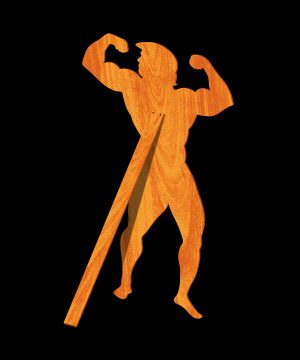 Remarkably, in these fractious times, President Trump has managed to forge a singular area of consensus among liberals and conservatives, Republicans and Democrats: Nearly everyone seems to agree that he represents a throwback to a vintage version of manhood. After Mr. Trump proclaimed his “domination” over coronavirus, saluting Marine One and ripping off his mask, the Fox News host Greg Gutfeld cast the president in cinematic World War II terms — a tough-as-nails platoon leader who “put himself on the line” rather than abandon the troops. “He didn’t hide from the virus,” Mr. Gutfeld said. “He was going to walk out there on that battlefield with you.” Senator Kelly Loeffler of Georgia tweeted an altered WrestleMania video in which the president was portrayed as pummeling senseless an opponent with a spiked coronavirus head. “President Trump won’t have to recover from Covid,” Representative Matt Gaetz of Florida gloated. “Covid will have to recover from President Trump.”
Remarkably, in these fractious times, President Trump has managed to forge a singular area of consensus among liberals and conservatives, Republicans and Democrats: Nearly everyone seems to agree that he represents a throwback to a vintage version of manhood. After Mr. Trump proclaimed his “domination” over coronavirus, saluting Marine One and ripping off his mask, the Fox News host Greg Gutfeld cast the president in cinematic World War II terms — a tough-as-nails platoon leader who “put himself on the line” rather than abandon the troops. “He didn’t hide from the virus,” Mr. Gutfeld said. “He was going to walk out there on that battlefield with you.” Senator Kelly Loeffler of Georgia tweeted an altered WrestleMania video in which the president was portrayed as pummeling senseless an opponent with a spiked coronavirus head. “President Trump won’t have to recover from Covid,” Representative Matt Gaetz of Florida gloated. “Covid will have to recover from President Trump.”
Meanwhile, the putatively liberal news media was conjuring its own version of the boxing ring: with Mr. Trump in one corner as atavistic chest-beater and Joe Biden in the other as evolved exemplar of feminist-sensitized manhood. Mr. Trump and Mr. Biden “evoke different brands of manliness,” a Washington Post article argued: Mr. Trump channels “old-fashioned machismo” — “aggressive, physically tough, physically strong, never back down” (in the words of a gender-equity educator, Jackson Katz) — while Mr. Biden models what Mr. Katz calls “a more complex 21st-century version of masculinity,” defined by “compassion and empathy and care and a personal narrative of loss.”
But what if the one thing people agree on, they’re wrong about? What if Mr. Trump’s style of bullying and bombast aren’t relics of the old manhood, but emblems of a masculinity very much au courant? If that’s so, we may be fooling ourselves in declaring that his noxious model is heading for a natural extinction.
More here.
Thursday, October 29, 2020
In a remarkably short time, digital technology has gone from being democracy’s handmaiden to its scourge. Such a dramatic turnaround should give us pause
Richard Hughes Gibson in The Hedgehog Review:
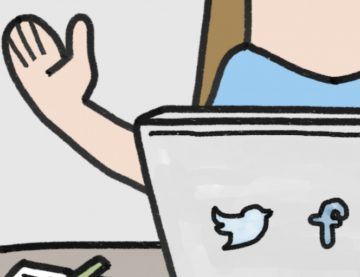 American society is prone, political theorist Langdon Winner wrote in 2005, to “technological euphoria,” each bout of which is inevitably followed by a period of letdown and reassessment. Perhaps in part for this reason, reviewing the history of digital democracy feels like watching the same movie over and over again. Even Winner’s point has that quality: He first made it in the mid-eighties and has repeated it in every decade since. In the same vein, Warren Yoder, longtime director of the Public Policy Center of Mississippi, responded to the Pew survey by arguing that we have reached the inevitable “low point” with digital technology—as “has happened many times in the past with pamphleteers, muckraking newspapers, radio, deregulated television.” (“Things will get better,” Yoder cheekily adds, “just in time for a new generational crisis beginning soon after 2030.”)
American society is prone, political theorist Langdon Winner wrote in 2005, to “technological euphoria,” each bout of which is inevitably followed by a period of letdown and reassessment. Perhaps in part for this reason, reviewing the history of digital democracy feels like watching the same movie over and over again. Even Winner’s point has that quality: He first made it in the mid-eighties and has repeated it in every decade since. In the same vein, Warren Yoder, longtime director of the Public Policy Center of Mississippi, responded to the Pew survey by arguing that we have reached the inevitable “low point” with digital technology—as “has happened many times in the past with pamphleteers, muckraking newspapers, radio, deregulated television.” (“Things will get better,” Yoder cheekily adds, “just in time for a new generational crisis beginning soon after 2030.”)
So one threat the present techlash poses is to obscure the ways that digital technology in fact serves many of the functions the visionaries imagined. We now take for granted the vast array of “Gov Tech”—meaning internal government digital upgrades—that makes our democracy go. We have become accustomed to the numerous government services that citizens can avail themselves of with a few clicks, a process spearheaded by the Clinton-Gore administration. We forget how revolutionary the “Internet campaign” of Howard Dean was at the 2004 Democratic primaries, establishing the Internet-based model of campaigning that all presidential candidates use to coordinate volunteer efforts and conduct fundraising, in both cases pulling new participants into the democratic process.
An honest assessment of the current state of digital democracy would acknowledge that the good jostles with the bad and the ugly.
More here.
Covid-19 deaths aren’t rising as fast in Europe and US, despite soaring new infections. That doesn’t mean the virus is less deadly
Ivana Kottasová at CNN:
 Recent case and fatality figures from the European Centre for Disease Prevention and Control (ECDC) show that while recorded Covid-19 cases are spiking in the United Kingdom, France, Spain, Germany and other European countries, deaths are not rising at the same rate.
Recent case and fatality figures from the European Centre for Disease Prevention and Control (ECDC) show that while recorded Covid-19 cases are spiking in the United Kingdom, France, Spain, Germany and other European countries, deaths are not rising at the same rate.
“The fatality rate has declined, in the UK, we can see it going down from around June to a low point in August,” said Jason Oke, a senior statistician at the Nuffield Department of Primary Care Health Sciences. “Our current estimate is that the infection fatality rate is going up a little bit, but it hasn’t come up to anywhere near where we were and that’s unlikely to change dramatically unless we see a really surprising increase in the numbers of deaths.”
Oke has been tracking Covid-19 fatality rates along with his colleague Carl Heneghan of the Centre for Evidence-Based Medicine and health economist Daniel Howdon. Their research shows that, at the end of June, the fatality rate was just below 3% in the UK. By August, it had dropped as low as about 0.5%. It now stands at roughly 0.75%.
“We think it’s probably driven a lot by age, but also other factors, like treatment,” Oke said.The lower death rate isn’t unique to Europe.
More here.
The Heart of the Matter: Translating the Heart Sutra
Leanne Ogasawara, and artwork by Morgan Fisher, in Kyoto Journal (republished here):

1.
Back in the Tang dynasty, it was the heart that mattered. Thinking too much, philosophers warned, will only give you a headache. This fact was supported by the finest investigations of Chinese physicians and theologians who urged people to “still their hearts” and “empty their minds” in order to achieve liberation from suffering.
But Chinese Buddhists of the 7th century had a big problem to solve. One that would require some heavy-duty thinking.
How to translate abstract philosophical terms from Sanskrit –a language with an extraordinarily rich epistemological and ontological lexicon– into Chinese, a language poor in abstract vocabulary.
Words had to be invented. And it wouldn’t be easy, for how can a translator know if a translation is correct if they don’t have access to the original text?
It was to this task that Xuanzang, the Buddhist monk and translator extraordinaire devoted his life. Read more »
Bruce Springsteen: “There’s no art in this White House”
[Thanks to Brooks Riley.]
Thursday Poem
Domestic Violence
1.
It was winter, lunar, wet. At dusk
Pewter seedlings became moonlight orphans.
Pleased to meet you meat to please you
said the butcher’s sign in the window in the village.
Everything changed the year that we got married.
And after that we moved out to the suburbs.
How young we were, how ignorant, how ready
to think the only history was our own.
And there was a couple who quarreled into the night,
Their voices high, sharp:
nothing is ever entirely
right in the lives of those who love each other.
2.
In that season suddenly our island
Broke out its old sores for all to see.
We saw them too.
We stood there wondering how
the salt horizons and the Dublin hills,
the rivers, table mountains, Viking marshes
we thought we knew
had been made to shiver
into our ancient twelve by fifteen television
which gave them back as gray and grayer tears
and killings, killings, killings,
then moonlight-colored funerals:
nothing we said
not then, not later,
fathomed what it is
is wrong in the lives of those who hate each other.
3.
And if the provenance of memory is
only that—remember, not atone—
and if I can be safe in
the weak spring light in that kitchen, then
why is there another kitchen, spring light
always darkening in it and
a woman whispering to a man
over and over what else could we have done?
4.
We failed our moment or our moment failed us.
The times were grand in size and we were small.
Why do I write that
when I don’t believe it?
We lived our lives, were happy, stayed as one.
Children were born and raised here
and are gone,
including ours.
As for that couple did we ever
find out who they were
and did we want to?
I think we know. I think we always knew.
by Eavan Boland
from Domestic Violence
W. W. Norton, 2007
These bizarre ancient species are rewriting animal evolution
Traci Watson in Nature:
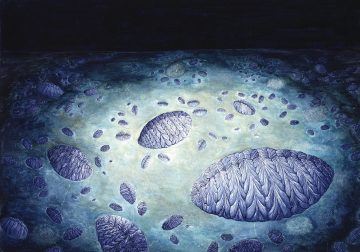 The revolutionary animal lived and died in the muck. In its final hours, it inched across the sea floor, leaving a track like a tyre print, and finally went still. Then geology set to work. Over the next half a billion years, sediment turned to stone, preserving the deathbed scene. The fossilized creature looks like a piece of frayed rope measuring just a few centimetres wide. But it was a trailblazer among living things. This was the earliest-known animal to show unequivocal evidence of two momentous innovations packaged together: the ability to roam the ocean floor, and a body built from segments. It was also among the oldest known to have clear front and back ends, and a left side that mirrored its right. Those same features are found today in animals from flies to flying foxes, from lobsters to lions.
The revolutionary animal lived and died in the muck. In its final hours, it inched across the sea floor, leaving a track like a tyre print, and finally went still. Then geology set to work. Over the next half a billion years, sediment turned to stone, preserving the deathbed scene. The fossilized creature looks like a piece of frayed rope measuring just a few centimetres wide. But it was a trailblazer among living things. This was the earliest-known animal to show unequivocal evidence of two momentous innovations packaged together: the ability to roam the ocean floor, and a body built from segments. It was also among the oldest known to have clear front and back ends, and a left side that mirrored its right. Those same features are found today in animals from flies to flying foxes, from lobsters to lions.
Palaeontologist Shuhai Xiao marvels at the tracks left by this creature, Yilingia spiciformis, and how they captured evidence of its movement. In his cluttered office at Virginia Tech in Blacksburg, he shows off a slab of beige resin — a reproduction of the fossil, which was found in China’s Yangtze Gorges region and is now kept in a Chinese research institute. The replica captures a snapshot of a moment from 550 million years ago. Xiao, whose team formally described Yilingia last year1, traces the bumpy tracks it made immediately before its death. “It was just moving around, and it died suddenly,” he says.
More here.
Misremembering the British Empire
Maya Jasanoff in The New Yorker:
 On a cloud-spackled Sunday last June, protesters in Bristol, England, gathered at a statue of Edward Colston, a seventeenth-century slave trader on whose watch more than eighty thousand Africans were trafficked across the Atlantic. “Pull it down!” the crowd chanted, as people yanked on a rope around the statue’s neck. A few tugs, and the figure clanged off its pedestal. A panel of its coat skirt cracked off to expose a hollow buttock as the demonstrators rolled the statue toward the harbor, a few hundred yards away, and then tipped it headlong into the water.
On a cloud-spackled Sunday last June, protesters in Bristol, England, gathered at a statue of Edward Colston, a seventeenth-century slave trader on whose watch more than eighty thousand Africans were trafficked across the Atlantic. “Pull it down!” the crowd chanted, as people yanked on a rope around the statue’s neck. A few tugs, and the figure clanged off its pedestal. A panel of its coat skirt cracked off to expose a hollow buttock as the demonstrators rolled the statue toward the harbor, a few hundred yards away, and then tipped it headlong into the water.
The Black Lives Matter movement has accelerated a reckoning across Europe about the legacies of slavery and imperialism, nowhere more urgently than in Britain, which presided over the largest empire in world history. The Colston statue stood on Colston Avenue, in the shadow of Colston Tower, on Colston Street, around the corner from Colston Hall. Scratch almost any institution with roots in Britain’s era of global dominance and you’ll draw imperial blood—from the Rhodes Trust, established by the fervent expansionist and white supremacist Cecil Rhodes, to the British Museum, whose founding collection was funded by profits from Jamaican plantations worked by slaves, and the Booker Prize, launched by a food company once notorious for its exploitative practices in the cane fields of British Guiana. Every year, the Queen honors hundreds of citizens with the Order of the British Empire. (A 2004 parliamentary committee recommended changing the name to the Order of British Excellence, to no avail.)
Public discussion in Britain about the imperial past has pivoted on a reductive question: Was the empire good or bad? The Labour Party has pledged to “ensure the historical injustices of colonialism, and the role of the British Empire” are “properly integrated into the National Curriculum,” while Boris Johnson, the Prime Minister, decries a “cringing embarrassment about our history.” A March, 2020, poll found that a third of Britons believed that their empire had done more good than harm for colonies—a higher percentage than in other former imperial powers, including France and Japan. More than a quarter of Britons want the empire back.
Asking, today, whether empire was good or bad is, as a historical matter, about as useful as asking whether the Atlantic Ocean is good or bad.
More here.
After George Steiner
Martin Jay at Salmagundi:
 And yet, despite his shifting placement in the dynamic force field of cultural politics, Steiner resisted turning into a curmudgeonly apologist for a world on the wane or allowing his Kulturpessimismus to sanction a resentful withdrawal from the public arena. In fact, one of the hallmarks of his career was a willingness to remain suspended within paradoxes, never forcing a simple choice between unpalatable options. This attitude was already evident in Language and Silence, which both celebrates humanistic high culture and acknowledges that the Holocaust has disabused us of the naïve illusion that it humanizes those who uphold it. Or as he put it in what is perhaps his most frequently cited sentences: “We come after. We know now that a man can read Goethe or Rilke in the evening, that he can play Bach or Schubert, and go to his day’s work at Auschwitz in the morning.”17 And yet, Steiner somehow never really faltered in his faith that great art remains the last refuge of meaningfulness in a world from which religious faith has fled.
And yet, despite his shifting placement in the dynamic force field of cultural politics, Steiner resisted turning into a curmudgeonly apologist for a world on the wane or allowing his Kulturpessimismus to sanction a resentful withdrawal from the public arena. In fact, one of the hallmarks of his career was a willingness to remain suspended within paradoxes, never forcing a simple choice between unpalatable options. This attitude was already evident in Language and Silence, which both celebrates humanistic high culture and acknowledges that the Holocaust has disabused us of the naïve illusion that it humanizes those who uphold it. Or as he put it in what is perhaps his most frequently cited sentences: “We come after. We know now that a man can read Goethe or Rilke in the evening, that he can play Bach or Schubert, and go to his day’s work at Auschwitz in the morning.”17 And yet, Steiner somehow never really faltered in his faith that great art remains the last refuge of meaningfulness in a world from which religious faith has fled.
more here.
Thomas De Quincey’s Revelatory Writing
Jane Darcy at the TLS:
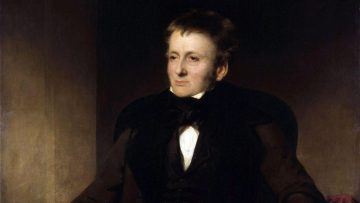
But to dismiss De Quincey as either a charming or a duplicitous figure on the margins of Romanticism is to ignore some of his most astonishing writing. He created a new kind of autobiography, constructed through resonant fragments grounded in dreams and reveries. Burwick describes him as “the first conscientious autobiographer of the interaction between conscious and subconscious experience”. He wrote eloquently on everything from political economy, psychology and Kantian philosophy to issues of literary style, but he could also sustain a highly inventive comic voice, notably in his satirical essays on violence. Robert Morrison, in this edition of Thomas De Quincey for the 21st-Century Oxford Authors series, presents an excellent selection for a new reader: Confessions and its sequel, Suspiria de Profundis, substantial extracts from his pleasingly waspish biographical essays from Recollections of the Lakes and Lake Poets and the great essays, including “On the Knocking at the Gate in Macbeth” and “On Murder Considered as One of the Fine Arts”. Morrison is an experienced De Quincey scholar, contributing to the The Works of Thomas De Quincey edited by Grevel Lindop (twenty-one volumes, 2000–3), editing the Oxford World’s Classics Confessions of an English Opium-Eater and Other Writings (2013) and writing a biography of De Quincey, The English Opium-Eater (2009). Because most of De Quincey’s writing appeared in journals, the task of sourcing his work has always posed editorial challenges. Added to this, De Quincey obsessively revised and rewrote his work, and his recovered manuscripts are often damaged and difficult to read. Morrison is a fine textual scholar, and in this edition includes interesting selections of manuscript material offering textual variants. Morrison’s extensive notes carefully explain matters such as De Quincey’s numerous Latin quotations (he was an exceptional, if somewhat tiresome, classicist), arcane vocabulary and new coinages.
more here.
Louise Bourgeois – Spiderwoman
Wednesday, October 28, 2020
The Agatha Christie Centennial: 100 Years Of “The Mysterious Affair At Styles”
J. Kingston Pierce in Crime Reads:
 Agatha Christie was in her mid-20s when, in 1916, she took up what seemed the improbable endeavor of penning her first detective novel. It was so unlikely, in fact, that her elder sister, Madge, with whom she had always competed, dared Agatha to accomplish the feat, certain of her sibling’s eventual failure.
Agatha Christie was in her mid-20s when, in 1916, she took up what seemed the improbable endeavor of penning her first detective novel. It was so unlikely, in fact, that her elder sister, Madge, with whom she had always competed, dared Agatha to accomplish the feat, certain of her sibling’s eventual failure.
At the time, Christie was married to an officer in Britain’s Royal Flying Corps and working at a hospital in Torquay, England, first as a nurse and subsequently in the dispensary, preparing and providing medicines. It was in the latter job that she developed a fascination with poisons that would endure over the next six decades, supplying murderous means in many of her best-known books, including that very first one, The Mysterious Affair at Styles, which was published 100 years ago this month.
Styles was an early and influential contribution to what’s now called the Golden Age of detective fiction, a period that stretched arguably from the 1920s through the 1940s.
More here.
What Victorian-era seaweed pressings reveal about our changing seas
Laura Trethewey in The Guardian:
 On his first day as the new science director for the Monterey Bay Aquarium in California in 2016, a giant blue storage locker caught Kyle Van Houtan’s eye. The locker was obscured by a dead ficus plant and looked as if no one had opened it for years. But the label on it intrigued him: Herbarium.
On his first day as the new science director for the Monterey Bay Aquarium in California in 2016, a giant blue storage locker caught Kyle Van Houtan’s eye. The locker was obscured by a dead ficus plant and looked as if no one had opened it for years. But the label on it intrigued him: Herbarium.
He opened it and inside found hundreds of stacked manila envelopes. Each one contained a single piece of seaweed, pressed and preserved on white paper.
The collection demonstrated a curator’s attention to detail, with neat labels in tidy handwriting that documented every seaweed’s origin and collector. And it gave Van Houtan and his colleague Emily Miller an idea.
More here.
The Party of Lincoln had a good run. Then came Mr. Trump.
The Editorial Board of the New York Times:
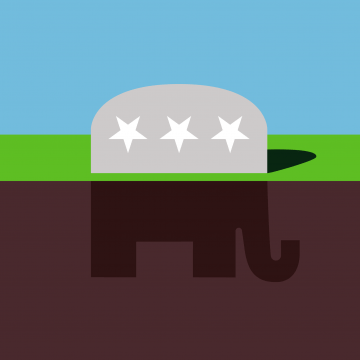 Senator John Cornyn of Texas, locked in his own tight re-election race, recently told the local media that he, too, has disagreed with Mr. Trump on numerous issues, including deficit spending, trade policy and his raiding of the defense budget. Mr. Cornyn said he opted to keep his opposition private rather than get into a public tiff with Mr. Trump “because, as I’ve observed, those usually don’t end too well.”
Senator John Cornyn of Texas, locked in his own tight re-election race, recently told the local media that he, too, has disagreed with Mr. Trump on numerous issues, including deficit spending, trade policy and his raiding of the defense budget. Mr. Cornyn said he opted to keep his opposition private rather than get into a public tiff with Mr. Trump “because, as I’ve observed, those usually don’t end too well.”
Profiles in courage these are not.
Mr. Trump’s corrosive influence on his party would fill a book. It has, in fact, filled several, as well as a slew of articles, social media posts and op-eds, written by conservatives both heartbroken and incensed over what has become of their party.
But many of these disillusioned Republicans also acknowledge that their team has been descending into white grievance, revanchism and know-nothing populism for decades. Mr. Trump just greased the slide. “He is the logical conclusion of what the Republican Party has become in the last 50 or so years,” the longtime party strategist Stuart Stevens asserts in his new book, “It Was All a Lie.
More here.
